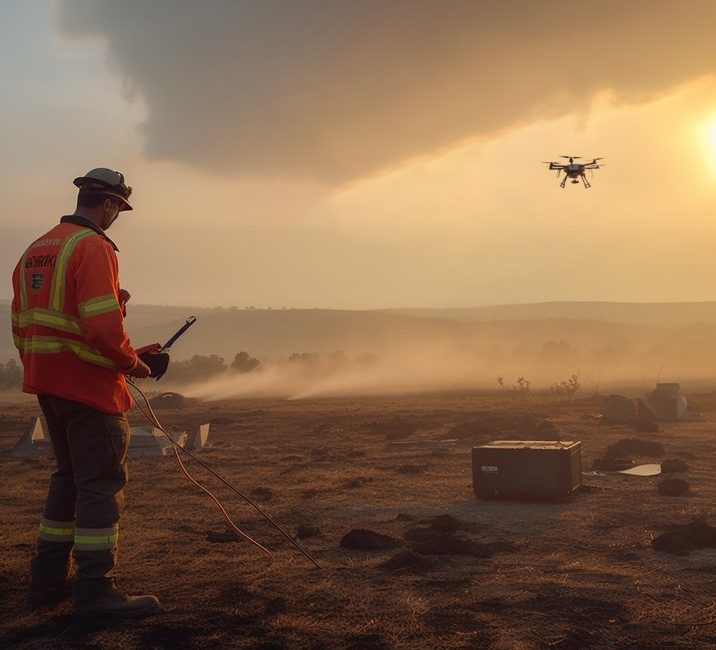In emergency response and disaster management, time is of the essence. The ability to gather accurate and timely information is crucial for effective decision-making and resource allocation. Drones have emerged as critical tools in emergency response and disaster management, providing valuable support in various stages of the disaster lifecycle. In this article, we will explore how drones are transforming emergency response and disaster management, the benefits they provide, and the different ways they are used as vital tools in these critical situations.
1. Rapid Situation Assessment
When a disaster strikes, the initial assessment of the situation is vital for determining the scale of the disaster and identifying areas that require immediate attention. Drones equipped with cameras and sensors can quickly and safely survey the affected areas, providing real-time imagery and data. This rapid situational assessment helps emergency responders and decision-makers understand the extent of the damage, identify potential hazards, and prioritize response efforts. Drones can cover large areas in a short amount of time, allowing for a comprehensive and timely assessment.
2. Search and Rescue Operations
During search and rescue operations, time is of the essence, and every minute counts. Drones equipped with thermal cameras and AI algorithms can help locate missing persons by detecting body heat signatures, even in challenging terrain or low-light conditions. These drones can quickly cover large areas, providing real-time video feeds to search and rescue teams on the ground. This aerial perspective improves the efficiency and effectiveness of search and rescue operations, increasing the chances of locating and rescuing survivors.
3. Damage Assessment and Infrastructure Inspection
After a disaster, assessing the damage to infrastructure is crucial for planning recovery efforts and allocating resources effectively. Drones can capture high-resolution imagery and videos of damaged areas, providing detailed information about the condition of buildings, roads, bridges, and other critical infrastructure. This data helps emergency management teams identify areas that are unsafe or in need of immediate repairs. By conducting infrastructure inspections using drones, responders can minimize the risk to personnel and quickly assess the extent of the damage.
4. Communication and Situational Awareness
Effective communication and situational awareness are essential in emergency response and disaster management. Drones equipped with communication systems can act as temporary mobile cell towers, providing connectivity and communication capabilities in areas where infrastructure has been damaged or destroyed. These drones can relay vital information, facilitate communication between response teams, and assist in coordinating rescue efforts. By establishing temporary communication networks, drones bridge the gap in communication and enhance situational awareness for all involved.
5. Environmental and Hazard Monitoring
Drones play a crucial role in monitoring environmental conditions and hazards during and after a disaster. They can collect data on air quality, water contamination, and the presence of hazardous materials. This information helps emergency management teams assess the potential risks to human health and the environment. Drones can also monitor the spread of wildfires, track the movement of floodwaters, and assess the stability of unstable structures. By providing real-time data on environmental conditions, drones help responders make informed decisions to mitigate risks and protect public safety.
6. Damage Documentation and Insurance Claims
Drones equipped with high-resolution cameras enable accurate and efficient documentation of damage for insurance purposes. Instead of relying on manual inspections, which can be time-consuming and dangerous, drones can capture detailed imagery and videos of affected properties. This documentation serves as valuable evidence for insurance claims, expediting the claims process and ensuring fair compensation for those affected by the disaster. The use of drones in damage documentation reduces the need for on-site assessments and minimizes the risk to insurance adjusters.
7. Training and Simulation Exercises
Drones are not only valuable tools during actual emergencies but also in training and simulation exercises. Emergency response teams can use drones to simulate disaster scenarios, allowing responders to practice their skills, test response plans, and evaluate their effectiveness. By incorporating drones into training exercises, responders gain valuable experience in utilizing this technology and understanding its capabilities. This preparation enhances the overall readiness of emergency response teams and improves their ability to effectively utilize drones during actual emergencies.
Conclusion
Drones have revolutionized emergency response and disaster management by providing rapid situational assessment, aiding in search and rescue operations, facilitating damage assessment and infrastructure inspection, enabling communication in remote areas, monitoring environmental conditions, documenting damage for insurance claims, and enhancing training and simulation exercises. The use of drones in these critical situations saves time, minimizes risks, and improves the effectiveness of emergency response efforts. As drone technology continues to advance, we can expect even more innovative applications that will further enhance emergency response and disaster management, ultimately saving lives and protecting communities.





